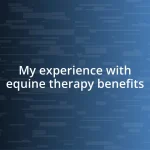Key takeaways:
- Horses communicate through body language, non-verbal cues, and emotional responses, which require careful observation and understanding to foster connection.
- Building trust with horses involves patience, consistency in routines, and respecting their individual personalities to develop deeper emotional bonds.
- Enhancing the riding experience can be achieved through mindfulness, setting small goals, and choosing serene locations, which strengthen the horse-rider connection.

Understanding horse communication
Horses communicate in ways that often go beyond words. I remember the first time I saw a horse’s ears swivel attentively; it was like a lightbulb moment for me. Those ears pointed forward indicate curiosity and interest, while pinned back can express irritation or fear—it’s a fascinating language that invites us to truly observe and connect with them.
Have you ever noticed how a horse’s body language can tell you exactly how they feel? I once stood next to a mare who nickered softly, and her relaxed stance spoke volumes. It was as if she was inviting me into her world, sharing a quiet moment of trust. These non-verbal cues are crucial; they carry emotions that words simply can’t capture.
Then there’s the subtlety of breathing and movement. I recall an experience with a young foal who approached me cautiously, mirroring my own calm demeanor. It struck me that horses are incredibly attuned to our energy and mood, reflecting what they sense in the environment. Isn’t it incredible how much we can learn from these sensitive creatures about connection and empathy?

Building trust with horses
Building trust with horses requires patience and understanding. When I first started working with horses, I learned that building a relationship is about more than just training or discipline; it’s about developing a bond. I remember spending endless hours simply standing in the paddock, allowing a gentle gelding to approach me at his own pace. Each time he inched closer, my heart swelled with a mix of anticipation and excitement.
Consistency and predictability are pivotal in earning a horse’s trust. I often think back to when I began establishing a routine with a spirited mare. I fed her at the same time each day and followed the same calm approach every morning. Over time, she began to seek me out, eager for our interactions. It’s amazing how such simple behaviors can foster a level of comfort that enables deeper connections.
To deepen that trust, I believe it’s essential to respect their individual personalities. Some horses may need more space initially, while others dive right into connection. I recall a poignant moment with a shy filly who initially avoided eye contact. After a few gentle sessions, she started meeting my gaze, and I felt a genuine connection bloom. That’s when I truly understood the power of patience and respect in building trust with these remarkable animals.
| Building Trust | Description |
|---|---|
| Patience | Allow horses to approach you on their own terms, fostering comfort. |
| Consistency | Establishing routines can help horses feel secure and build familiarity. |
| Respect for Individuality | Recognizing each horse’s unique personality promotes stronger bonds. |

The importance of body language
Understanding a horse’s body language is like peering into their very soul. I vividly remember a moment with a spirited mare; as she stomped her front hoof and flicked her tail, I felt a rush of urgency that mirrored her agitation. It was clear she needed space, a gentle reminder that I must always be attuned to what she was expressing. When we learn to interpret these signals, we become better partners, fostering mutual respect and understanding.
Recognizing even the subtlest cues can enhance our connection with these magnificent creatures. Here’s what I believe are key aspects of body language in horses:
- Ears Position: Forward ears indicate curiosity or alertness, while pinned-back ears suggest discomfort or annoyance.
- Eye Contact: Soft eyes show relaxation, whereas wide eyes can indicate fear or surprise.
- Tail Movement: A swishing tail may signal irritation, but a relaxed tail often means contentment.
- Posture: An upright, alert stance suggests attentiveness, while a lowered head can indicate submission or relaxation.
By observing these nuances, we can nurture a deeper bond with horses, allowing for a richer understanding of their emotions and needs.

Developing emotional connections
Developing an emotional connection with horses is a nuanced process that requires us to foster a sense of safety and understanding. I remember a time when I was introducing a new horse to my routine; she seemed hesitant, hiding at the far end of the paddock. I chose to sit quietly on the ground, allowing her to see that I meant no harm. Slowly, she began to inch closer, curious about this stranger who was simply there to listen. It was a magical moment, realizing that patience could unveil trust.
As I delved deeper into building emotional bonds, I found that sharing experiences made a significant impact. There was a rainy afternoon when I decided to groom my horse in the shelter. I could feel her tension melting away with every brushstroke, her head resting comfortably against my arm. In that moment, it wasn’t just grooming; it was a shared experience that fostered an unspoken bond. I felt how the warmth of that connection could transform our relationship, encouraging her to trust me more. Have you ever experienced that kind of emotional exchange with an animal?
Emotional connections flourish when we resonate with their feelings. I vividly recall the day my horse spooked at a sudden noise. Instead of reprimanding her, I took a moment to acknowledge her fear. I stood close, letting her sense my calmness wash over her. It was in that shared vulnerability that I realized how important it is to align our emotions with theirs. This understanding creates a bridge that deepens the relationship, making it not just about riding or handling, but a genuine partnership built on feeling and empathy.

Training techniques for better bonding
One of the most effective training techniques I’ve utilized for stronger bonding with horses is positive reinforcement. I recall the first time I tried clicker training with my gelding; the idea was to reward him for small actions, like lowering his head or stepping closer. After a few sessions, he began to understand that his efforts would be met with praise or a tidbit of his favorite treat. This turned our practice into a fun game rather than a chore, and I found that our trust in each other blossomed with every click.
Incorporating groundwork exercises is another technique that’s made a remarkable difference in my relationships with horses. I remember the first time I introduced liberty work, where I let my mare roam free within a designated space. At first, she was unsure, a bit hesitant to engage without the constraints of her halter. But when she finally started to move with me, I experienced a profound connection, as if we were communicating without words. Those moments taught me that allowing them freedom can actually enhance our physical and emotional connection.
Lastly, soft-spoken cues and gentle touch can go a long way. I vividly remember how one quiet evening, I spent time with my horse simply talking to him while I brushed his coat. With each soothing word, I noticed him relaxing further into my touch. Have you ever seen how horses respond to a calm voice? This practice not only reassured him but also reinforced our bond. By creating a safe, peaceful environment, we deepen the sense of partnership, making our interactions profoundly meaningful.

Benefits of equine companionship
There’s something truly special about the companionship horses provide. I recall an afternoon spent lounging beside my mare, her soft presence a comforting constant in my life. As we basked in the sun, I felt a serene connection that often quieted the chaos in my mind. Has there ever been a moment with an animal that just made everything else fade away? For me, those moments with horses transform anxiety into peace, providing a respite that’s hard to find in the hustle of daily life.
On a deeper level, the bond with horses offers emotional support that is profound. I remember a particularly challenging week at work when everything seemed to weigh heavily on me. When I visited the stable, I felt my burdens lift as my horse nuzzled my shoulder, bringing a sense of comfort that words couldn’t capture. It’s funny how these four-legged creatures know when we need them the most. This connection fosters an understanding that transcends verbal communication, reminding me that true companionship lies in shared emotions and silent support.
Through this journey, I’ve come to realize that the presence of a horse encourages mindfulness. I often find myself lost in the rhythm of grooming, focusing solely on the bond we share. It’s a gentle reminder to be present, to appreciate the simple joy of connection. Have you experienced such grounding moments? Horses have this unique ability to draw us into the present, emphasizing the importance of living in the moment and creating memories that linger long after the day is done.

Enhancing your riding experience
One way I’ve found to enhance my riding experience is through intentional mindfulness during our sessions. For instance, before I mounted my horse, I took a moment to breathe deeply and connect with him, feeling the warmth of his coat under my fingertips. Have you ever noticed how that simple act of grounding can change the entire atmosphere? It quieted my racing thoughts, allowing us to synchronize our movements, which led to a more harmonious ride.
Another aspect that elevates my riding is setting small goals for each session. I remember a day when I decided to focus solely on achieving smooth transitions between gaits. By doing this, I felt more engaged, and my horse responded with enthusiasm as we tackled each challenge together. The joy of celebrating even minor achievements strengthened our connection. Isn’t it rewarding when both horse and rider feel a sense of accomplishment together?
I’ve also realized that the choice of riding location plays a crucial role in our experience. On a particularly magical morning, I took my horse out to a quiet trail that wound through a wooded area. The sights and sounds of nature engaged both of us in a way that a bustling arena never could. That ride allowed for exploration and adventure, adding layers to our experience. Have you ever found a hidden gem of a path that transformed your time in the saddle? It’s these moments spent in serene environments that make riding more than just a skill—it’s a chance to connect deeply with our horses and the world around us.














